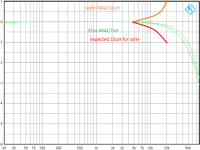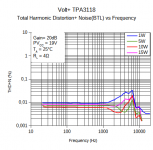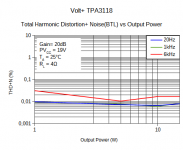If i look closely, i see that you measurements are done at 20dB gain while all datasheet plots are for 26dB. So it's not comparable.
Why do I get the feeling that no matter what we make public ,you will always find a problem with it.
We published the data , its clear that Volt+ is one of the best TPA3118 implementation .
You could graciously admit so..
Why do I get the feeling that no matter what we make public ,you will always find a problem with it.
Because there's always a systematic mistake with the stuff you publish.
The first measurements you posted where absolutely nonsense, and no-one at your team checked that before publishing them.
You compare your measurements to the EVM data but do your measurements at a different gain level. You simply can't compare this data directly.
If your board has better performance than the EVM, kudos to you and your team.
Getting kudos simply needs a minimum level of scientific work or proper engineering.
But you still didn't proved.
This all isn't mean in any personal offending matter.
Edit:
One thing really makes me wonder. From your measurements the Volt+ has decreasing THD+N with increasing output-power, how does this work?
Last edited:
waow, that's aggressive comments...
???

One thing really makes me wonder. From your measurements the Volt+ has decreasing THD+N with increasing output-power, how does this work?
???

I don't see any aggression in my comment from a German point of view. 
One thing to note:
It seems that the channels where swapped for the 5W and 15W measurement, as they measure worse on the other measurements.
1W: Ch2 worse
5W: Ch2 better
10W: Ch2 worse
15W: Ch2 better
Anyway i'll compile some data to see the performance more clear.
One thing to note:
It seems that the channels where swapped for the 5W and 15W measurement, as they measure worse on the other measurements.
1W: Ch2 worse
5W: Ch2 better
10W: Ch2 worse
15W: Ch2 better
Anyway i'll compile some data to see the performance more clear.
Last edited:
Because there's always a systematic mistake with the stuff you publish.
The first measurements you posted where absolutely nonsense, and no-one at your team checked that before publishing them.
You compare your measurements to the EVM data but do your measurements at a different gain level. You simply can't compare this data directly.
If your board has better performance than the EVM, kudos to you and your team.
Getting kudos simply needs a minimum level of scientific work or proper engineering.
But you still didn't proved.
This all isn't mean in any personal offending matter.
Edit:
One thing really makes me wonder. From your measurements the Volt+ has decreasing THD+N with increasing output-power, how does this work?
Yes , the first data I published was sent from testing team and I publish it without checking. I simply posted the data
Second yes you are right you cannot compare , but you could admit its a good implementation .. thats all that I have been asking.
Third you say that its "strange" to see that THD+N is increasing with W ...ok lets check a bit from engineering point of view.
1W highest THD. Could that be explained by the fast that we used 4ohm termination instead of 8ohm as we designed the filter ?
15W---second highest Ok that checks
10W-5W data is very close but under the 15W.
Higher levels THD+N On 5W the higest (0.015) and on 10W is 0.02 (so it checks)
Lower levels THD+N : Could it be that at levels of 0.007 vs 0.0055 anything matters including RF, temperature skews , common mode noise ??
I am not offended by your comments drmord and I understand that from your German point of view you have no aggression.
Take this from an Canadian point of view (mine) . You look at our data with negative mindset and try to see problems , like above , where there are none .
You seem like a brilliant engineer and give a lot back to community and this is something that I respect about you.
What I cannot respect is you , not accepting the fact that our proud Indian team has come out with a "cheap" tpa 3118 with (very) good specs and you are unable to say so..
Do you have a graph for that ?
No it's not.I thought your Volt+ is "immune" to power-supply-noise"?
With this cheap 24V/6A it's pretty noisy, in my low level desktop listening, but it's acceptabel compared to Sanwu amp and FX-Audio 802D.
DC 24V 6A 150W High Power Switching Power Supply Board Power Module | eBay
On their home site they say:"Please note that Class D amplifier needs a quiet PSU."
But it works damn good with my Kingrex linear PSU.
Best amp I heard with that PSU.
And it's almost ,not dead, quiet.
But I agree with you doctormord, measurements should be correct done.
We have enough with alternative facts these days...
I compared/measured some more data with other 3118 implementations, so far Volt+ is clearly winning for output power > 2W.
For the fact of having a "negative mindset", well yes, i'm "oversceptical" by nature.
Cheers.
Thx you .
Hadn't read info on Volt+ in a while. I see it is indeed one of the better measuring TPA3118 amplifiers out there. Those that have one already knew that by listening I guess
- Home
- Vendor's Bazaar
- New FIFO buffer for RPI/SBCs



 Yeez..
Yeez..